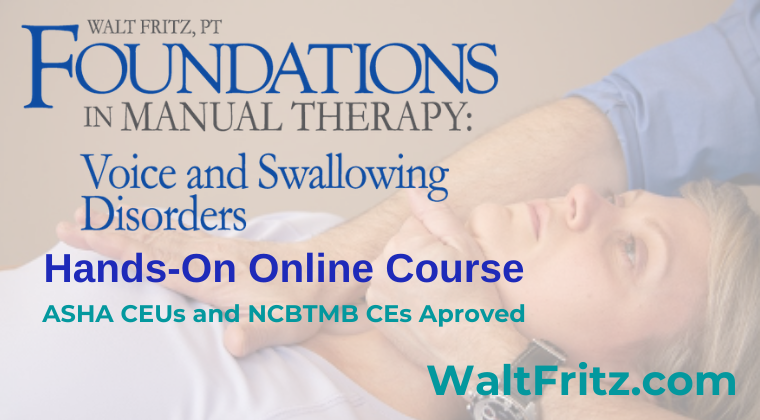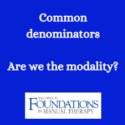Are we the modality? A common denominator
The longer I exist in the world of manual therapy, the more I see little difference between styles of work or modalities. Despite claims of unique access to single tissues or pathologies, all manual therapy is performed in remarkably similar ways. What are the underlying qualities of each of the dozens (or hundreds) of seemingly unique brands of manual therapy that link their positive outcomes? I believe it to be the therapeutic relationship rather than the way one treats or the tissues one thinks they are accessing.
What thinks you?
Despite claims of tissue or pathology specificity, in the end we are touching people. Can a specific style of stretch or input bias our ability to single out a specific tissue, structure, or supposed pathology to the exclusion of others? Reflexology makes claims to access specific points in the foot reflecting on the general health and well-being, but can one remove from the interaction that the clinician is actively listening to the patient’s complaints or concerns and attending to those needs? Myofascial release claims domain over impacting restricted fascia by using long, slow, static holds throughout the body, but can one have certainty that is it fascia alone they are impacting and not muscle or, even forbid, skin? Massage typically uses a muscle-centric model to explain both the problem and the solution. Still, does using lotion and gliding on the skin assure us that muscles are the primary target?
Typically a messy argument ensues when such thoughts are posted to social media, as the tribalism of each modality or style of work creates angst among its many users. Having been indoctrinated to the mysteries of fascia and the lack of education on the part of physicians and others in healthcare on its importance, I can well relate to such tribalistic actions. But what is it that links the various manual therapy interventions that we all use?
Diane Jacobs and Jason Silvernail (1) wrote a paper many years back comparing the traditional way clinicians act in their roles. They viewed these traditional roles as one of the operator, where the clinician calls all of the shots, and the patient acts in a passive role. They compare this concept with a preferred alternative, viewing the clinician in the role of the interactor. Through this role, the clinician adopts a role that allows and requires decisions to be shared by both parties, allowing the patient’s values and expectations to be better represented. This view, and the views of many others (2-5), is moving the bar of manual therapy’s effects from clinician-driven tissue-based perspectives into interactional effects from a successful therapeutic relationship.
As I read therapists defend their modality or style of interaction regarding manual therapy, I was struck by the thought that instead of the modality being what is done to the tissues, the modality may be the clinician themself. Few follow the rigid, pre-ordained protocols or historical narratives of any given modality without personalizing it to meet their way of treating or thinking or combining it with other styles. While therapists tend to see themselves as blending one modality to another as the situation demands, are they not in the role of creator, providing unique experiences to each individual patient? They are, hopefully, crafting the experience to meet the needs of the patient in an N of 1 fashion. Even when I thought myself an MFR purist I seldom sought out for my patient to unwind (though MFR training insists that such movement or emotional expressions come only from the patient; the clinician is simply the facilitator), seeing it as probably out of the scope of practice of a physical therapist as well as not representing what I was comfortable expecting of my patients. Sure, some clinicians are applying a routine to the patient that varies little from one patient to the next, but few would be accused of robotically applying exactly the same procure to each person. We personalize every session. Are we applying a modality? That would depend on how you define the term, and it is a very loosely defined term under the best of circumstances.
Instead of seeing ourselves as a follower of a model or educator, might it not be more accurate to see ourselves as the provider of a unique service? Our training, education, and experiences all form who we are, but we allow ourselves to be branded under the label of one person’s line or brand…and we do it quite willingly? Enthusiasm for a certain work can cause us to take on that branding. We are told that it is good for business, as it allows the public to find you, that special someone, in a sea of mediocre clinicians (sale-pitches like this are common in the continuing education field!). There is nothing wrong with this, but mightn’t it be better advertising to promote ourselves, instead of the person who taught us? The same positive impacts can be seen from seeing a professional who promotes causative ideas relating to dehydration, gluten intolerance, sugar overload, insufficient protein/fat in the diet, lack of vitamins, etc. Somehow, people are helped by all of these interventions and beliefs. Does that person just so happen to find their way to the expert who specializes in the exact thing that is deficient or problematic in your tissues, or are there aspects of relationship-building that can be credited with at least some of the positive impacts?
What is the common denominator that makes all of us successful, that allows us to help patients no matter what intervention we use? I see much of this fall to the therapeutic relationship that we build with the patient. As an observer on this ride of ours through life, I’ve made it a hobby to observe how clinicians treat, how they engage patients, how they speak to them, and how they include (or not include) the patient in the decision-making process. Like it or not, there are remarkable similarities to what all of us do. While binds us together?
The therapeutic relationship is complex. We see ourselves as the giver of knowledge and techniques. Our patients see us in a similar light and hope that we are the person who knows exactly what to do to help them. Often they switch clinicians regularly, as when one doesn’t help them, they assume that there must be someone else who can. Often they the past clinicians as not having the special training or knowledge that the next one will when it is possible it was that the past therapist didn’t have the right ability to form a successful relationship like the next one does.
These are fuzzy concepts and ones that are easy to pick apart. Picking apart is often what we do when our beliefs are challenged, and I am guessing that I have seriously challenged some core beliefs in readers. I mean no disrespect to what you’ve learned and experienced, as those experiences are strong glue that binds us to our beliefs. I might ask you to reflect on how it is that we all find ways of helping others when what we do and believe is so vastly different? Are their common denominators? Might we, and the relationships we build, be the modality?
- Jacobs, D. F., & Silvernail, J. L. (2011). Therapist as operator or interactor? Moving beyond the technique. The Journal of manual & manipulative therapy, 19(2), 120–121. https://doi.org/10.1179/106698111X12998437860794
- Bialosky, J. E., Beneciuk, J. M., Bishop, M. D., Coronado, R. A., Penza, C. W., Simon, C. B., & George, S. Z. (2018). Unraveling the Mechanisms of Manual Therapy: Modeling an Approach. The Journal of orthopaedic and sports physical therapy, 48(1), 8–18. https://doi.org/10.2519/jospt.2018.7476
- Geri, T., Viceconti, A., Minacci, M., Testa, M., & Rossettini, G. (2019). Manual therapy: Exploiting the role of human touch. Musculoskeletal science & practice, 44, 102044. https://doi.org/10.1016/j.msksp.2019.07.008
- Bishop, M. D., Torres-Cueco, R., Gay, C. W., Lluch-Girbés, E., Beneciuk, J. M., & Bialosky, J. E. (2015). What effect can manual therapy have on a patient’s pain experience?. Pain management, 5(6), 455–464. https://doi.org/10.2217/pmt.15.39
- Anjum, Rani Lill; Copeland, Samantha; Rocca, Elena. (2020). Rethinking Causality, Complexity and Evidence for the Unique Patient. 10.1007/978-3-030-41239-5
Walt Fritz, PT
Please consider checking out my upcoming live seminars, including the ASHA CEU and NCBTMB CE approved Balancing the Body. You will also find my online course offerings, including a full hands-on online course. You can find the information here. Also, read up on my in-person seminars at the links in the menu on this page.




Sorry, comments are closed for this post.